High Energy Cosmic Rays
November 13, 2017
While the
night sky may look peaceful, we live in a very
energetic universe. The most energetic bits of
matter in the universe are the invisible
cosmic rays that travel at nearly the
speed of light (300,000
km/sec). I've written about cosmic rays in several articles (
High Altitude Radiation, March 2, 2017,
Cosmic Ray Source, February 20, 2013, and
Local Dark Matter/A Hundred Years of Cosmic Rays, August 17, 2012.
Cosmic rays are
nuclei of the
elements, usually just
hydrogen nuclei (
protons). These apparently travel for millions of years at near-light speed from their distant sources before reaching the
Earth.
Supernovas have been the on again, off again, leading contenders as cosmic ray emitters.[1-2] Observations by the
orbiting Fermi Gamma-ray Space Telescope have shown that supernovas are the principal source of cosmic rays, but there are other sources.
The first evidence for cosmic radiation was found in the late
18th century when
French physicist Charles-Augustin de Coulomb, found that an isolated
charged sphere in supposedly
insulating air would slowly lose its charge.[2]
Wilhelm Röntgen discovered
X-rays in 1895, and it was found that X-rays would induce an
electrostatic charge. In my days of
chemical photography, I had a
film negative dusting brush that incorporated a
mild radiation source as a means of detaching dust from the
acetate film by the same principle.
Experiments were performed to examine the charge state of air in a
lead vessel that would
shield X-
radiation, the air still became ionized, so another form of radiation was suspected.
This radiation was discovered by the
Austrian scientist,
Victor Hess, who is credited with the discovery of cosmic rays, a discovery for which he shared the 1936
Nobel Prize in Physics. Hess decided to test whether this ionizing radiation was generated by a substance in the
Earth, or elsewhere. On August 7, 1912, Hess ascended in a
balloon to an
altitude of five
kilometers, where he found that the ionization happened at three times the rate at ground level.[2]

Victor Hess, returning from his balloon flight on August 7, 1912.
(American Physical Society photograph, via Wikimedia Commons)
While supernovas produce high energy cosmic rays, there are some very high energy cosmic rays thought to emanate from
jets associated with
black holes.[3] Some ultra-high energy cosmic rays are thought to have an
extragalactic origin.[4]. One example of an extremely energetic cosmic ray is the
Oh-My-God particle, detected to have an energy of 3 x 10
20 eV, which is 40 million times that of a
proton in the
Large Hadron Collider.
Are cosmic rays just a scientific oddity; or, is their presence important to Earth? While
space suits and
spacecraft provide a measure of
shielding against high
intensity radiation, these don't shield against all cosmic radiation.
Astronauts first noticed cosmic rays as
random flashes of light. On
lunar missions, the
Apollo astronauts reported these flashes about once every three minutes, other astronauts in Earth
orbit have seen these about half as often, and a 2001 study showed a higher incidence of
cataracts in former astronauts who have flown in space, some cataracts having appeared as soon as 4-5 years after the missions.[5]
![]()
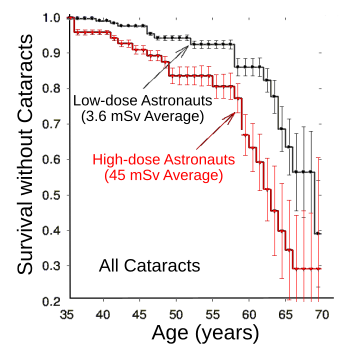
Incidence of cataracts for NASA astronauts as a function of age.
The radiation dose effect is clearly evident, and getting cataracts in your thirties is unusual for ordinary people.
(Created with Inkscape from data in ref. 5.[5]
![]()
Cataracts are a minor risk compared with
cancer, as shown in a recent article that assesses the cancer risk from cosmic rays for travel to
Mars.[6] The health hazard of radiation exposure is typically estimated using a
linear dose model, a model that's been
controversial for at least the last half century. It appears that the radiation exposure estimate for travel to Mars based on conventional models, while still quite high, might be a two-fold underestimate of the actual hazard.[6]
As shown in the figure, cosmic rays at
Earth's surface are a considerable portion of radiation from all sources. As I wrote in an
earlier article (Semiconductor Radiation Damage, August 3, 2012), there are about 10,000 of the lowest energy particles (1
GeV = 10
9 eV) impinging on a square meter's area every second, dropping to one per square meter at a
TeV (10
12 eV). Such a high
flux has an affect on
electronic materials as well as
biological materials.
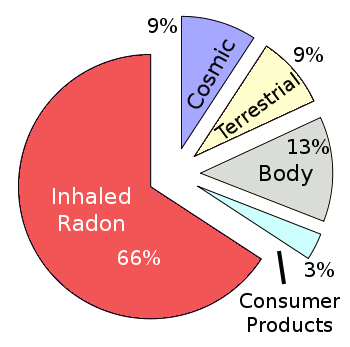
Environmental radiation sources.
Surprisingly, the human body, itself, emits radiation.
From NCRP Report #93, "Ionizing Radiation Exposure of the Population of the United States" (1987), via Lawrence Berkeley National Laboratory.
(Rendered using Gnumeric)
Electronic devices are susceptible to "
soft errors" that occur when a cosmic ray strikes an
integrated circuit. This generate millions of
electron-hole pairs, and these stray
charges can change the state of
transistor logic gates and
memory circuits.
Error-correcting software can compensate to some extent, but our shrinking transistors make such corrections more of a problem, since more than a single
bit might be affected.
It's been more than a hundred years since Victor Hess discovered cosmic rays, but scientists are still trying to determine the source of the most energetic rays. I mentioned earlier that the detected energy of one cosmic ray, the appropriately named, "Oh-My-God particle," had an energy of 3 x 10
20 eV. Now, the
Pierre Auger Collaboration, an international team of more than 400 scientists from a hundred institutions in eighteen countries responsible for the
Pierre Auger Observatory has determined to a high certainty that the highest-energy cosmic rays have an
extragalactic origin.[7-11]
The principal
detectors of the Pierre Auger Observatory are 1600
Cherenkov detectors distributed over 1,200 s
square miles (3,000
square kilometers) in
Argentina (see figure). These detectors utilize an effect noted by
Nobel Physics Laureate,
Pavel Cherenkov, in 1934. In this effect, a charged particle will emit light when moving in a
dielectric medium (such as
water) at a speed greater than the
phase velocity of light in that medium.
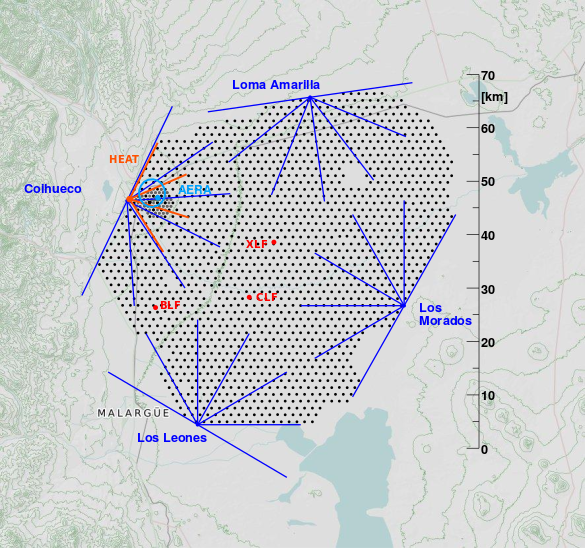
Layout of the Pierre Auger Observatory. The dots are the 1,600 Cherenkov detectors, which are huge tanks of water monitored for flashes of light. Image by Darko.veberic, via Wikimedia Commons
Such a massive detector is required for such a study, since few high energy cosmic rays reach the Earth. Cosmic rays with an energy greater than two
joules have a
flux at the top of Earth's atmosphere of just one per square kilometer per year.[11] These particles are detectable only because their impact with air
molecules produces a
cascading shower of
electrons,
photons and
muons containing more than 10 billion particles.[11] These air shower particles will cover an area in excess of 40 square kilometers by the time they reach the ground.[9]
The 1,600 Cherenkov detectors of the Pierre Auger Observatory in Argentina, which has been gathering data since 2004, are sited in a 3,000 square kilometer area, equivalent to the size of
Rhode Island near the town of
Malargüe in western Argentina.[9]
GPS receivers detect the arrival times for the
air shower particles, and these times determine the direction within about one
degree.[9-11]
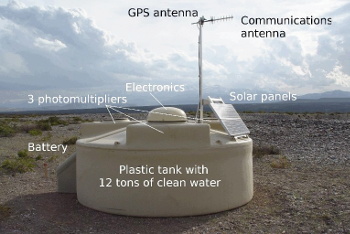
One of 1,600 Cherenkov detectors of the Pierre Auger Observatory.
Pierre Auger Observatory image.
(Click for larger image.)
The Pierre Auger Collaboration found a slightly
dipolar distribution of 30,000 detected cosmic rays with energies greater than 8 x 10
18 electron volts detected at more than a 5.2-
sigma level of significance.[7] This
anisotropy had an amplitude of about 6.5 percent toward
right ascension 100 ±10 degrees and
declination -24 (+12, -13) degrees. That direction indicates an extragalactic origin for these ultrahigh-energy particles.[7] The
statistical significance is a chance of about two in ten million.[11] This is a region of the sky located 120 degrees from the
galactic center, so it cannot be associated with any galactic source. These cosmic rays have an extragalactic origin.[9]
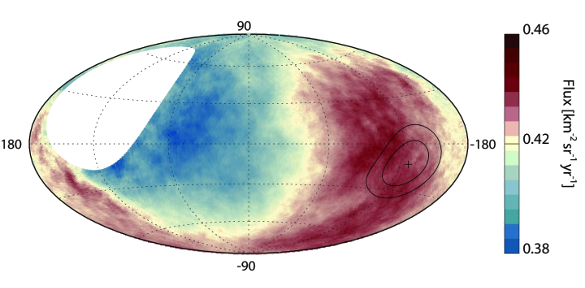
Cosmic ray anisotropy as found by the Pierre Auger Observatory. The galactic center is at the center of the ellipse, and the central region of excess cosmic rays is circled. (Pierre Auger Collaboration image.)
Says
Karl-Heinz Kampert, a
professor at the
University of Wuppertal and spokesperson for the Auger Collaboration,
"We are now considerably closer to solving the mystery of where and how these extraordinary particles are created—a question of great interest to astrophysicists... Our observation provides compelling evidence that the sites of acceleration are outside the Milky Way."[10]
While there is clearly an extragalactic origin for the particles, the observations are not precise enough to pinpoint specific cosmic ray sources.[11]
magnetic fields in
space will still modify the
trajectory of even at these high energy particles, but observations of even higher-energy cosmic rays, planned for an observatory upgrade to be completed in 2018, will help.[10-11]
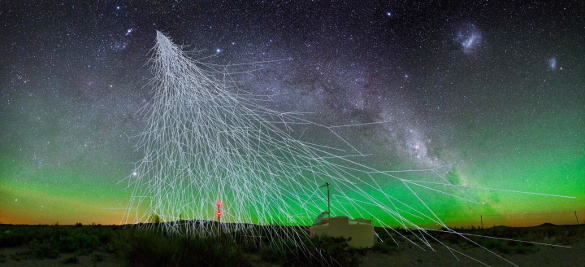
Artist's impression of an air shower over a Cherenkov detectors at the Pierre Auger Observatory, seen against a starry sky. Cosmic rays create a shower of electrons, photons and muons through successive interactions with the nuclei in the atmosphere. These air showers can contain more than 10 billion particles.[11] (Illustration by A. Chantelauze, S. Staffi, and L. Bret.)
References:
- 100 years of cosmic rays mystery, Institute of Physics Press Release, July 31, 2012.
- Alan Watson, "100 years of cosmic rays," Physics World, Aug 1, 2012.
- Jonathan Amos, "Cosmic rays: Fermi telescope settles mystery of origin," BBC News, February 14, 2013.
- Matthew Francis, "Supernova observations solve the mystery of cosmic-ray origins," Arstechnica, February 14, 2013.
- Francis A. Cucinotta, "Space Radiation Risks for Exploration," National Academies of Sciences Web Site, May 30, 2013.
- Francis A. Cucinotta and Eliedonna Cacao, "Non-Targeted Effects Models Predict Significantly Higher Mars Mission Cancer Risk than Targeted Effects Models, "Scientific Reports, vol. 7, Article no. 1832 (May 12, 2017), doi:10.1038/s41598-017-02087-3. This is an open access article with a PDF file available here.
- The Pierre Auger Collaboration, "Observation of a large-scale anisotropy in the arrival directions of cosmic rays above 8 × 1018 eV," Science, vol. 357, no. 6357 (September 22, 2017), pp. 1266-1270, DOI: 10.1126/science.aan4338.
- John S. Gallagher III, and Francis Halzen, "Perspective, Astronomy - New angle on cosmic rays," Science, vol. 357, no. 6357 (September 22, 2017), pp. 1240-1241, DOI: 10.1126/science.aao5651.
- Highest-energy cosmic rays have extragalactic origin, CNRS Press Release, September 22, 2017.
- Louise Lerner, "Observatory detects extragalactic cosmic rays hitting the Earth," University of Chicago Press Release, September 22, 2017.
- Kelley Christensen, "Detecting Cosmic Rays from a Galaxy Far, Far Away," Michigan Tech News, September 21, 2017.
Linked Keywords: Night sky; energy; energetic; universe; matter; cosmic ray; speed of light; km/sec; atomic nucleus; nuclei; chemical element; hydrogen; proton; Earth; supernova; orbit; orbiting; Fermi Gamma-ray Space Telescope; 18th century; France; French; physicist; Charles-Augustin de Coulomb; electric charge; charged; sphere; insulator; insulating; air; Wilhelm Röntgen; X-rays; electrostatic; chemical; photography; film negative; dust; brush; alpha decay; radiation source; cellulose acetate; experiment; lead; radiation protection; shield; radiation; Austria; Austrian; scientist; Victor Hess; Nobel Prize in Physics; Earth; balloon; altitude; kilometer; American Physical Society; Wikimedia Commons; relativistic jet; black hole; extragalactic cosmic ray; Oh-My-God particle; electronvolt; eV; Large Hadron Collider; space suit; spacecraft; intensity; astronaut; randomness; random; cosmic ray visual phenomena; flashes of light; Moon; lunar; Apollo program; cataract; NASA; absorbed dose; radiation dose; Inkscape; cancer; Mars; linear dose model; Earth's surface; GeV; eV; TeV; cosmic ray flux; semiconductor; electronic material; tissue; biological material; human body; Lawrence Berkeley National Laboratory; Gnumeric; soft error; integrated circuit; carrier generation and recombination; electron-hole pair; transistor; logic gate; random-access memory; memory circuit; error-correcting software; bit; Pierre Auger Collaboration; Pierre Auger Observatory; extragalactic astronomy; particle detector; Cherenkov radiation; Cherenkov detector; square mile; square kilometer; Argentina; Nobel Physics Laureate; Pavel Cherenkov; dielectric; water; phase velocity; joule; molecule; cascading shower; electron; photon; muon; Rhode Island; Malargüe; Global Positioning System; GPS; receivers; air shower; degree; dipole; dipolar; standard deviation; sigma; statistical significance; level of significance; anisotropy; right ascension; declination; galactic center; ellipse; Karl-Heinz Kampert; professor; University of Wuppertal; astrophysics; astrophysicist; acceleration; Milky Way; magnetic field; outer space; trajectory; artist.